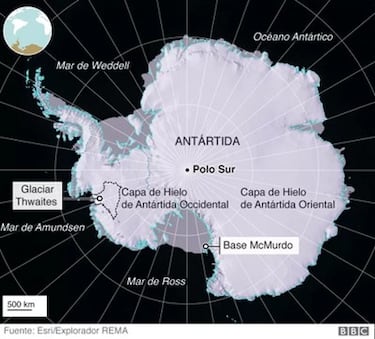The Doomsday Glacier is melting faster than we thought—here’s why it matters
The massive Thwaites Glacier in Antarctica, ominously known as the “Doomsday Glacier,” is melting at a rate that scientists say could be more dangerous than anticipated.

Stretching over 75 miles, the Thwaites Glacier is one of Antarctica’s largest ice masses, comparable in size to the state of Pennsylvania. Known as the “Doomsday Glacier” for the potentially catastrophic impact its melting would have, Thwaites holds enough ice to significantly increase global sea levels. At about 1,300 yards deep, it’s twice the diameter of Gran Canaria Island, and scientists studying it for years report that warming ocean waters are causing the glacier to shrink faster than previously feared.
Why protecting Thwaites matters
Thwaites Glacier is essential to stabilizing the Antarctic ice sheet, which has prompted scientists from countries in the Antarctic Treaty to monitor it closely. If Thwaites collapses, experts warn sea levels could rise anywhere from 2 feet to as much as 10 feet according to more pessimistic predictions—enough to alter coastlines globally.

What happens if Thwaites melts?
Thwaites Glacier is essential to stabilizing the Antarctic ice sheet, which has prompted scientists from countries in the Antarctic Treaty to monitor it closely. If Thwaites collapses, experts warn sea levels could rise anywhere from 2 feet to as much as 10 feet according to more pessimistic predictions—enough to alter coastlines globally.
What happens if Thwaites melts?
Losing the Thwaites Glacier could trigger a chain reaction across the Antarctic ice sheet, further raising sea levels. Scientists believe this glacier functions like a linchpin for surrounding ice masses, meaning that its collapse could accelerate the melting of ice across the continent, bringing additional, unpredictable consequences. Since 1880, sea levels worldwide have risen by about 9 inches. But a sudden increase of even 2 feet could devastate coastal cities, and if predictions of a 10-foot rise materialize, it would create an unparalleled natural disaster.
Coastal cities on high alert
Related stories
Even slight rises in sea levels put coastal cities in jeopardy. New York, situated on a bay, could see extensive flooding with even minor increases. Venice, already vulnerable to flooding, would be even more exposed. In Bangkok, just 18 miles from the coast and barely above sea level, a rise would likely flood the city’s canals, putting millions at risk. Additionally, countless low-lying islands face direct threats, with their populations at the mercy of these rising waters.
Article by Rubén Criado. Translated with the assistance of AI and edited by David Nelson.
Complete your personal details to comment